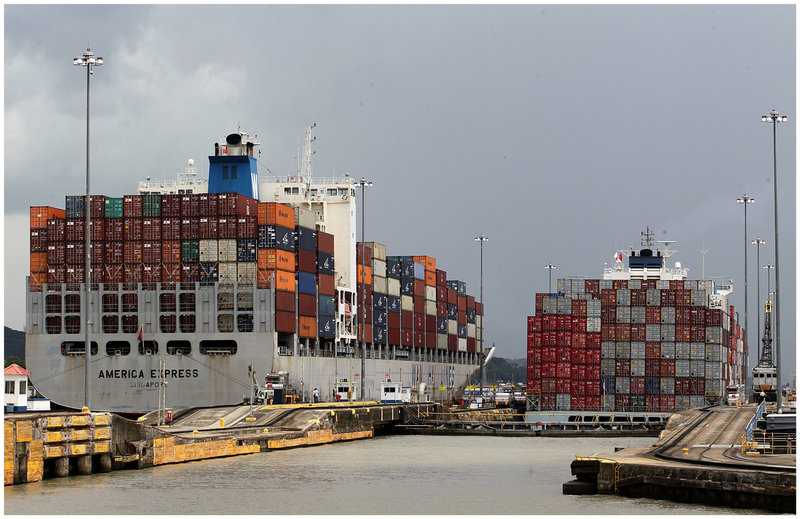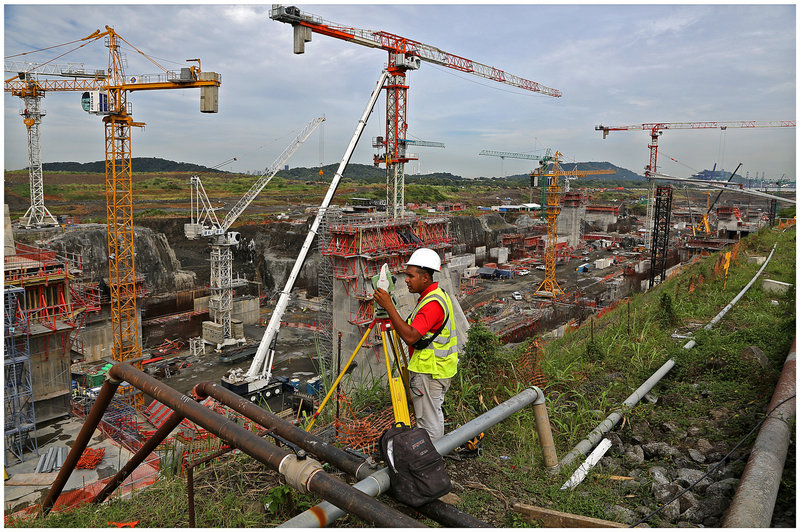Huge yellow dump trucks resemble Tonka toys in a sand pile as they haul tons of rust-colored dirt and basalt rock from a 56-foot gash in the earth that will become a new access channel in the $5.25 billion expansion of the Panama Canal.
The trucks keep rumbling up muddy terraced slopes as a quick-moving storm blurs the horizon. The rain chases away workers pouring concrete for a mammoth set of locks that will lift super-size ships for their transit across the narrow Isthmus of Panama, but the crews are back in the pit as soon as the sun returns.
By April 2015, it will all be under water — ready for the ever-bigger vessels revolutionizing international trade. The expansion is expected to double the canal’s capacity.
The 2015 target is about six months behind schedule, but U.S. ports are still scrambling to ready their channels for so-called post-Panamax ships, and some say they welcome the reprieve.
At this point, Baltimore and Norfolk, Va., are the only ports along the Eastern Seaboard with channels deep enough to handle the vessels when they’re fully loaded.
It’s a race for deep water as ports up and down the East Coast and along the Gulf of Mexico make plans to dredge their channels, shore up their docks or rustle up funding for renovations to receive the big ships. Many won’t be ready by the time water floods the new locks.
As this new phase of canal construction nears completion, with 13,000 people working around the clock, there is renewed interest in preserving the history of the old Panama Canal Zone as well as the legacy of those who worked and died building the canal.
While the 50-mile-long Panama Canal has provided a maritime shortcut between the Atlantic and Pacific for almost a century, it’s just about maxed out.
This year, vessels from the four corners of the globe — car carriers from Japan, bulk carriers loaded with soybeans and wheat from the U.S. heartland, oil tankers, towering container ships carrying the output of Chinese factories to U.S. retailers — are expected to move a record 332 million tons of cargo through the waterway, said Jorge L. Quijano, chief executive of the Panama Canal Authority.
That’s only about 20 million tons short of the canal’s capacity, he said. The canal is also popular with cruise lines, and dozens of cruise ships are being built that exceed the size limits of the current canal.
But the more immediate problem is that the huge cargo ships increasingly favored for trade with Asia are too wide, too long and too heavy for the current canal.
With a growing number of ships in the post-Panamax category — exceeding the specifications for the largest ship that can fit through the existing locks — the Panama Canal must expand or risk losing market share.
And post-Panamax vessels aren’t even the biggest on the high seas. Post-Panamax Plus ships, such as most U.S. tankers that carry liquefied natural gas bound for Asia, are five times too big for the Panama Canal.
While Panamanians take great pride in their canal and their success in running the waterway since the United States returned the canal to Panama in 1999, there’s still plenty at stake for the United States with the expansion.
Two-thirds of the goods that move to and from the United States cross the Panama Canal, and the United States is the canal’s leading customer.
Walmart, Lowe’s, Home Depot and Target are clamoring to import products from Asia not only more quickly but also more cheaply.
“Time is money,” said U.S. Trade Representative Ron Kirk. The expansion of the canal “can have an explosive impact on our ability to move goods from the United States to other parts of the world.”
ANOTHER MARVEL
If construction of the original Panama Canal, which was completed in 1914, was the moonshot of its era, the current canal project also is something of an engineering marvel.
Some 4.2 million cubic meters of concrete — about 40 percent more than for the original canal — will be poured by the time the new three-chambered locks are completed.
Each 180-foot-wide, 1,400-foot-long chamber could accommodate the Empire State Building laid on its side. The gates for the locks, which are being built in Italy, will soar 10 stories high.
The canal’s new set of locks will allow a ship with a 160-foot beam to pass with ease. The current canal can accommodate only ships that are no more than 106 feet wide and 965 feet long. Some of the largest ships in this category — with containers stacked seven-deep on their decks — look like they’re barely able to squeeze through today’s locks.
Most of these vessels carry around 5,000 standard 20-foot containers. But the post-Panamax behemoths can stretch the length of three football fields and will carry as many as 13,000 containers as they make the eight-to-10-hour journey through the canal.
In terms of tonnage, they’re three times as heavy as current Panama Canal ships, hence the need for deeper channels and wider locks.
The canal expansion isn’t about moving more ships so much as accommodating bigger ones. Since 1965, the number of ships traversing the canal annually has remained at about 14,000, but the tonnage they transport has tripled.
“The business of the canal is to move cargo, not vessels. It’s basically how much tonnage can you move. The expansion makes the canal much more efficient,” said Alberto Aleman, the former chief executive of the Panama Canal Authority.
The authority charges as much as $400,000 for a container ship to use the canal, and it’s working out fees for the new locks.
“We need to make sure we attract volume, so we don’t want to charge prices that will be too high,” said Rodolfo R. Sabonge, vice president for market research and analysis.
He said the fee schedule also needs to provide enough incentive so shippers will continue to send smaller ships through the current locks rather than switching all their cargo to post-Panamax vessels.
Currently three sets of locks — two on the Pacific side and one on the Atlantic side — help ships step up or down to the water level of Gatun Lake, an artificial lake that is 85 feet above sea level, and they’ll continue to function for smaller ships after the expansion is completed.
The expanded section will use much of the existing canal, whose channels are being dredged to make them wider and deep enough for post-Panamax ships, but it will operate with just a single set of locks on the Pacific side instead of the current two.
To connect the new Pacific locks to the original canal, a 3.8-mile access channel that runs parallel to the current canal is being dug.
As dump trucks carried out boulders from the excavation, the Cap Castillo, a container ship flagged in Monrovia, appeared to float on the horizon as it made its way through the nearby Pedro Miguel locks.
This is the only place along the 50-mile length of the canal where the old and new come together so dramatically.
Since the expansion began, some 25,000 people, about 90 percent of them Panamanian, have worked on various phases of the project.
Despite the scope of the expansion, it is still far different from the last century, when steam shovels gouged the channel out of the jungle with dirt trains running on tracks along the bottom of the trench to haul out tons of rock and earth.
Workers had to blast through the rock of Culebra Cut and tens of thousands of laborers — most from Barbados and other Caribbean islands — succumbed to malaria, yellow fever, precarious living conditions and the perils of carrying boxes of unstable dynamite during the failed French attempt at building the canal and the Americans’ later engineering success.
Since the expansion began, there have been four deaths.
This time around, there’s a lot more equipment and far fewer people involved and more water-saving features are built into the design, said Ilya Espino de Marotta, engineering and programs management executive vice president for the expansion.
The canal authority had hoped all work on the expansion, including six months of testing of the new locks, would be done by October 2014, the 100th anniversary of the canal opening. But the consortium building the $3.2 billion locks says a 2015 delivery date is more likely, de Marotta said.
Now, the onus is on the consortium building the locks, which is led by companies from Belgium and Spain. Each day the project is late will result in a $300,000 penalty for the consortium with a cap of $54 million.
The good news is that the expansion, which has involved 228 contractors to date, is still on budget.
Copy the Story Link
Send questions/comments to the editors.





Success. Please wait for the page to reload. If the page does not reload within 5 seconds, please refresh the page.
Enter your email and password to access comments.
Hi, to comment on stories you must . This profile is in addition to your subscription and website login.
Already have a commenting profile? .
Invalid username/password.
Please check your email to confirm and complete your registration.
Only subscribers are eligible to post comments. Please subscribe or login first for digital access. Here’s why.
Use the form below to reset your password. When you've submitted your account email, we will send an email with a reset code.